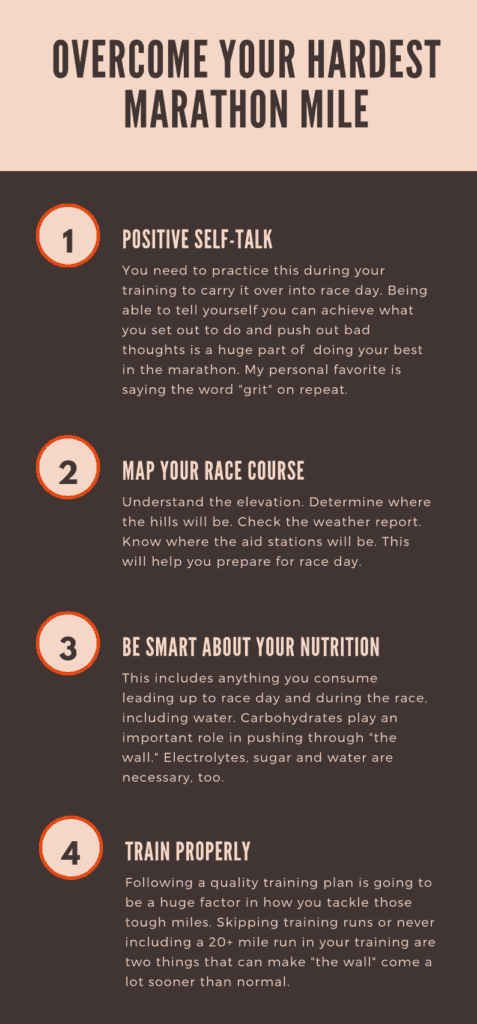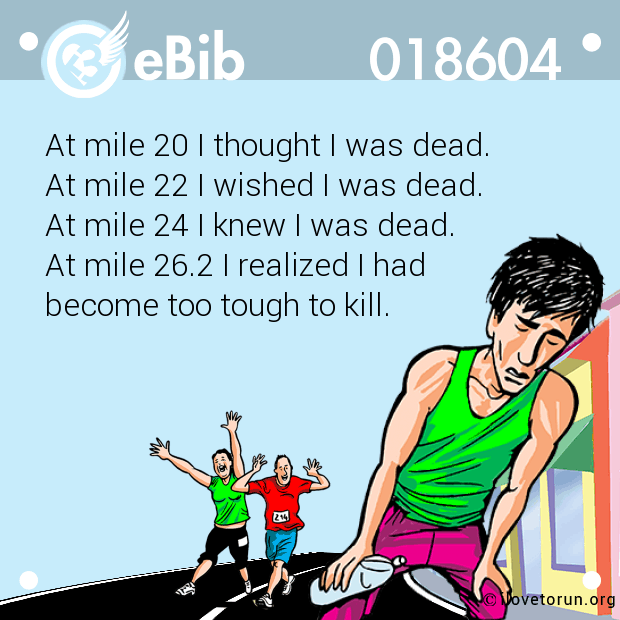When you make the decision to run a marathon, you know it’s going to be tough. It’s quite possibly one of the hardest things you will ever put yourself through. It is the culminating event in which you showcase months of hard work, test your mental will, and find out if your training was enough. Though you’re excited for what’s to come, it’s only natural that self-doubt starts to creep in as the race draws closer. Being mentally prepared for the toughest parts of your race can actually give you the edge you’ll need to push through. Pinpointing where the hardest mile will fall in your particular race is much better than going in blindly and crossing your fingers that you make it to the other side.
So, what is the hardest mile of a marathon? The hardest mile of the marathon is usually between miles 18 through 23, though it’s not going to be the same for every runner. Generally, a runner can hold a steady pace for the majority of the race before feeling a physical wall where the pace becomes difficult. Mentally, the race becomes tougher, too.
If you were looking for a definitive answer in which I told you the exact mile in which you would have this feeling, I’m sorry to say I don’t have it. Our bodies, our minds, our training…they are not the same. However, I do think it’s important to know that it’s coming and what it’s going to feel like when it arrives. I think sharing my personal experience along with the science behind it will allow you to prepare as much as you possibly could.
Determining the Hardest Marathon Mile
As part of your training, it’s important that you understand the particular race you are training for. All of this information is going to help you train more purposefully as well as help you visualize how you’re going to attack the more challenging parts of your race. It will also affect when the hardest mile of your marathon might come. Some things to consider are:
- Elevation: If your race is going to be higher up than where you’re training, it’s going to be more difficult to get oxygen, which is discussed in this article.
- Hills: A race with more change in elevation is going to be more difficult than a flat race. Looking at the course layout and finding where those tough hills are going to be will prepare you better.
- Weather: You can get some sense of this way ahead of time by looking at average race day/month temperatures. Looking at the weather reports in the days leading up to the race will ensure you have the right clothing and gear. Not being warm enough, dry enough, staying hydrated, etc. enough are all things that can botch a race. Don’t let bad weather stress you out, just plan accordingly to prepare.
- Aid Stations: I personally carry all of my own water and nutrition, but many people don’t. Find out ahead of time at which miles there will be aid stations as well as what will be offered. Training with the same products you will be taking during the race can help you. Knowing when gels will be available is also important. You don’t hit your “hardest mile” sooner than you have to.
These are factors dependent on your particular race that can affect the difficulty of the course. They can affect where and when you might come upon your hardest mile. But there are also areas of the race (in about the last 2/3) which that hardest mile is much more likely to fall. They can be both physical and mental blocks. It will be hard, but it is not impossible.

It’s Still So Far to Go: Miles 18-19
Getting to the point where you really realize how far you’ve come, yet how much farther you still have to run, can create the hardest mile of your marathon. I have run 5 marathons. This thought crept in every single time.
Before the 18-mile mark, you are probably running at a pretty even pace. Hopefully, you were smart at the beginning of your race without going out too fast and also held back on the hills a bit to save energy. If you didn’t, you’ll probably struggle more at these miles than the average runner. Most runners who have trained properly and stayed conservative through their race will probably come up to these miles still feeling good.
During my Colorado marathon, I remember coming up to these miles feeling happy and with good energy. I had my family cheering me on throughout various points through the race. I was taking in the beauty around me and I felt strong. Even though I felt good, a negative thought began to creep into my head. I quickly went from, “I’m feeling so good!” to, “Ugh, I still have 8 more miles to go! That’s so far!” Once you start doing this, it can be hard to dig yourself out of this self-wallowing hole. I started to think, “That’s longer than a 10k! That’s over another hour! And I’m already so tired! I don’t know if I can make it that much farther without walking…”
I would love to just tell you not to do this, but more realistically, you have to practice positive self-talk for when you start to think these thoughts. Re-framing my thinking and reminding myself I had done everything right to prepare for this day is how I pushed through.
The point at which these thoughts come up don’t have to make this begin the hardest miles of your marathon. Training with positivity will lead to positivity in your race that can erase this destructive mindset.
On the other hand, had you not raced on the cautious side during the first half of your race, physical difficulties might already be setting in by this point as well. We call this “the wall.”
The Wall: Miles 20-21
The last 1/3 of the marathon bring about both psychological and physiological factors that begin to affect your performance. Chances are that by miles 20-21 you’ve already had to wrestle with your negative thoughts and hopefully were able to push them aside. That would mean you are arriving at these miles still feeling good and holding the pace. The fatigue you’ve met up to this point has probably felt manageable and you’re excited to be within that last 10k of the finish line. Right as you’re thinking about how many 10ks you’ve run and that it’s no big deal, you look down at your watch and see that you’ve fallen behind.
This is the point at which you’re convinced your pace hasn’t changed at all, except you see the proof. So, you start pushing harder and the pace is barely improving. You get tired. You start to feel drained and exhausted.
There are scientific reasons in which we feel a sudden change in our endurance later in a marathon. Even though you’ve overcome mental hurdles throughout your race, you still have to overcome the physical ones that present themselves much more often later in the race. One of the biggest issues is that your body at this point has used all of its glycogen stores. What your body is used to using to drive your running, is suddenly gone. This doesn’t mean you have no energy at all. At this point, your body starts converting fat into energy which is a much slower process. According to this study, “Endurance running severely taxes carbohydrate stores which, unlike fat reserves, can be performance-limiting because they are comparably small.”
You will feel much more tired as a result, but that doesn’t mean you can’t dig deep to push through. Knowing that this could be the reason for the hardest mile in your marathon will help you be prepared to consume your nutrition properly prior to and throughout your race (think carbohydrates). This is also another excellent reason not to go out too fast.

Running Further Than You Did in your Training: Miles 22-23
By now, you’ve had to overcome both physical and mental barriers. Hopefully, you’re also realizing by these miles that you are stronger than you ever thought possible. What happens late in the race is that have to stick to your positive mantras you set for yourself. These miles are very likely going to be the hardest you’ll ever tackle.
- You still have negative thoughts you have to push away. This is human nature and exhaustion can make it worse.
- Your glycogen stores are still depleted. Once this happens you’re not going to be able to replace them.
- Foreign aches and pains are possibly presenting themselves as well. Your body hurts.
- You realize you never ran this far in your training. The majority of training plans are going to have your longest runs be 20-22 miles long. Venturing into uncharted territory can be scary. But it can also be exhilarating. Being able to frame your mindset is going to be a huge piece of you getting you through that initial tough mile and beyond.
There is a reason your plan or coach didn’t have you run further than this in your training. This is the point at which your point truly begins to break down. Especially since your pace is (should be) much stronger than the pace at which you ran your long runs.
Once all of the above factors come together, you will most likely face your toughest mile. The reason it’s probably at miles 22-23 as opposed to the last couple of miles is that it’s easier to convince your brain that you can finish by that point. At least that’s my experience.
Overcoming the Hardest Mile of the Marathon
The hardest mile of your marathon is going to be very individual. It’s not the same for everyone. But none of this is supposed to scare you about your upcoming marathon. Rather, I hope that it helps you prepare for the difficulties that are bound to come your way. There is a reason that less than 1 percent of the population has run a marathon. Just remember…if it was easy, everyone would do it! Now go out and tackle that hardest mile.








